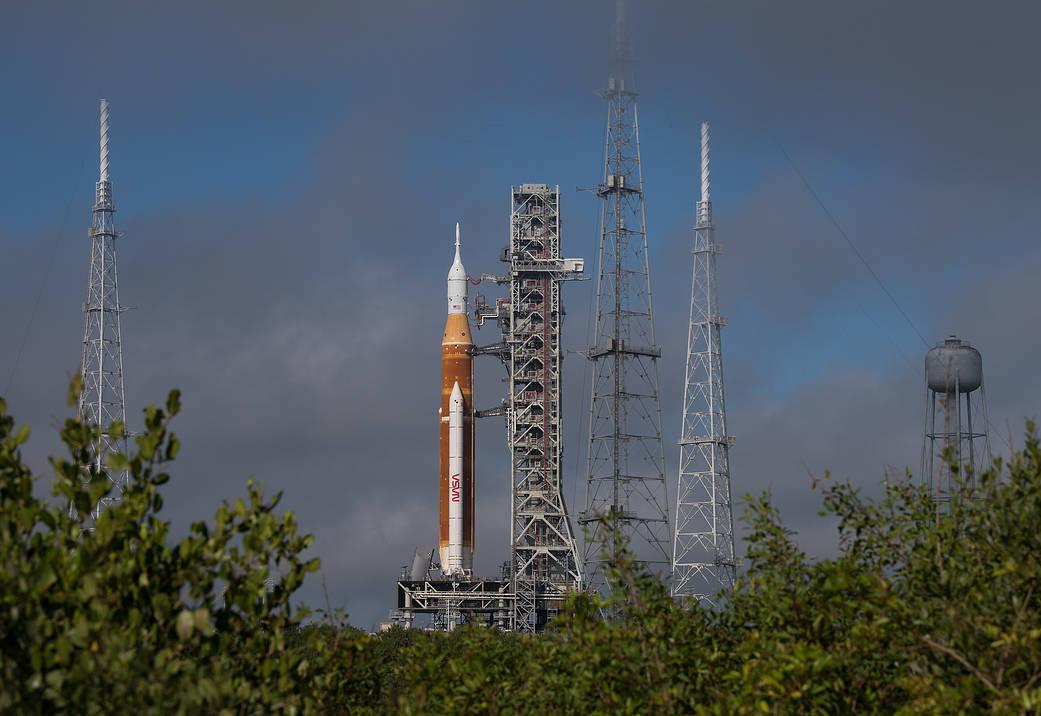
NASA is eager to kick off the next major milestone in preparation for the first launch of the Space Launch System (SLS) and Orion crew capsule—its Wet Dress Rehearsal (WDR).
The launchpad simulation is focused on the propellant loading phase of the countdown for Artemis I, a multiweek test flight of Orion without astronauts aboard that will travel around the Moon and back to Earth for a Pacific Ocean splashdown.
The two-day WDR at Kennedy Space Center’s (KSC) Launch Pad 39B is expected to get underway April 1 at 5 p.m. EDT with a “call to station” for the personnel involved in the preparation of liquid oxygen and hydrogen propellant loading aboard the SLS core and Interim Cryogenic Propulsion upper stage.
The WDR should conclude April 3 by about 5 p.m. EDT, after participants take the countdown activities down to the 33-sec. mark, cycle back to a 10-min. hold point and continue down to 10 sec. prior to what would be liftoff.
If all goes well, the SLS and Orion will then be rolled back to KSC’s Vehicle Assembly Building, from which it emerged for the WDR on March 17, where the hardware will be checked out while the outcome of the test is assessed.
Potentially, NASA leadership may be able to provide an actual launch schedule by the week of April 11, Tom Whitmeyer, NASA’s deputy associate administrator for common exploration systems development, told a March 29 news briefing.
“I think we have done everything to get ready,” Whitmeyer said. “We will find out soon enough.”
The long-term weather outlook appears promising, though there is a possibility of stormy weather. The launch team and weather officer will be assessing possible constraints that include a 20% chance or more of lightning within 5 nm (5.75 statute miles) of the launchpad and winds in excess of 37.5 kt. (42.5 mph).
Much of the WDR team’s confidence in the simulation’s unfolding in a constructive sense is the amount of effort that has gone into preparation, according to Charlie Blackwell-Thompson, KSC’s Artemis launch director.
“This is the first time up, and it’s a test. So I’m certain as we go through [we will learn things]. Certainly if we have any kind of issues that we have to go address, that will affect the timeline,” Blackwell-Thompson said. “We have tested all of the individual pieces. We have also run the software through a number of different simulations along with the team.”
Those at KSC will be joined by personnel at NASA’s Marshall Space Flight Center in Huntsville, Alabama, which is overseeing the development of the SLS; NASA’s Johnson Space Center (JSC) in Houston, which has overseen the development of Orion; and staff from the Mission Control Center.
“This is a good practice run,” said NASA’s Howard Hu, the Orion program manager at JSC. “We will have our engineering team from JSC and Mission Control do checkouts of the primary power, propulsion and communications systems. The flight software will be running and the hatch closed.”
If Artemis I launches in the weeks following the WDR, a follow-on test flight, Artemis II, could send astronauts around the Moon and back to Earth in 2024. Artemis III, the first post-Apollo mission to land astronauts on the Moon, could follow in 2025.
